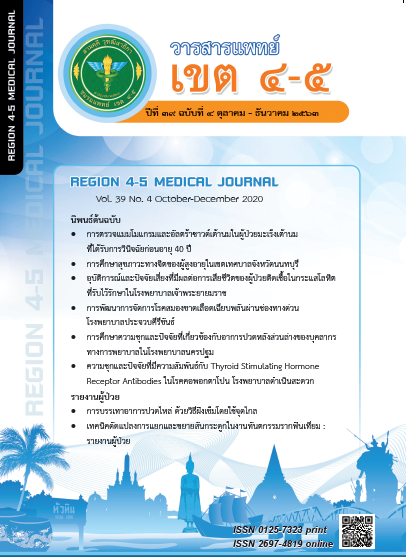ปัจจัยที่มีความสัมพันธ์กับการฝากครรภ์ไม่ครบตามเกณฑ์ของหญิงตั้งครรภ์ ที่มาคลอดบุตรที่โรงพยาบาลราชบุรี
คำสำคัญ:
การฝากครรภ์, ฝากครรภ์ไม่ครบตามเกณฑ์บทคัดย่อ
บทคัดย่อ
วัตถุประสงค์: เพื่อศึกษาปัจจัยที่มีความสัมพันธ์ต่อการฝากครรภ์ไม่ได้คุณภาพในหญิงตั้งครรภ์ที่มาคลอดในโรงพยาบาลราชบุรี
วิธีการศึกษา: เป็นการศึกษาแบบควบคุมในหญิงตั้งครรภ์จำนวน 400 ราย ที่มารับบริการคลอดยังโรงพยาบาลราชบุรีในช่วง 1มกราคม-30 กันยายน 2562 เครื่องมือที่ใช้วิจัยได้แก่แบบสอบถามจากการสัมภาษณ์ ประกอบด้วยข้อมูล 4ส่วนคือ ข้อมูลทั่วไป แบบวัดความรู้ เจตคติเกี่ยวกับการฝากครรภ์และความพึงพอใจต่อการบริการ วิเคราะห์ข้อมูลโดยใช้สถิติวิเคราะห์ในโปรแกรมสำเร็จรูป
ผลการศึกษา: จากการศึกษาพบหญิงตั้งครรภ์จำนวน 180ราย (ร้อยละ 45)มาฝากครรภ์ไม่ครบตามเกณฑ์ส่วนใหญ่มีอายุอยู่ในช่วง 20-35ปี การศึกษาระดับมัธยม รายได้ต่อเดือนต่ำ มีบุตรหลายคน และไม่มีประวัติความเสี่ยงสูงต่อการตั้งครรภ์ พบความสัมพันธ์ของการมาฝากครรภ์ไม่ครบตามเกณฑ์ในมารดาที่มีสถานะแยกทางกันกับสามี การศึกษาต่ำ รายได้ต่ำ มีบุตรหลายคน และเป็นครรภ์ที่มีความเสี่ยงต่ำ อย่างมีนัยสำคัญทางสถิติ โดยการศึกษานี้พบว่าสตรีทั้งสองกลุ่มที่มาฝากครรภ์ครบและไม่ครบตามเกณฑ์มีความรู้ เจตคติ ความพึงพอใจต่อการรับบริการค่อนข้างสูง และไม่แตกต่างกัน
สรุป: มารดาสถานะหย่าร้าง การศึกษาต่ำ รายได้ต่ำ มีบุตรหลายคน และเป็นครรภ์ที่มีความเสี่ยงต่ำ เป็นปัจจัยที่มีความสัมพันธ์ต่อการมาฝากครรภ์ไม่ครบตามเกณฑ์
References
1. Joshi C, Torvaldsen S, Hodgson R, et al. Factors associated with the use and quality of antenatal care in Nepal: a population-based study using the demographic and health survey data. BMC Pregnancy Childbirth. 2014; 14: 94. doi: 10.1186/1471-2393-14-94.
2.World Health Organization. World Health statistics 2012 [Internet]. [cited year2017 july10]; Available from: apps.who.int/iris/bitstream/10665/44844/1/9789241564441_eng.pdf.
3. Dowswell T, Carroli G, Duley L, et al. Alternative versus standard packages of antenatal care for low-risk pregnancy. Cochrane Database Syst Rev. 2010;10:CD000934.doi: 10.1002/14651858.CD000934.pub2.
4. World Health Organization. Antenatal Care in Developing Countries Promises, achievements and missed opportunities [Internet]. 2017 [cited 2018 April 4];Available from:http://www.who.int/mediacentre/factsheets/fs348/en/
5. Isaac B, Charles M, Alice H. Factors associated with late antenatal care attendance in selected rural and urban communities of the copperbelt province of Zambia. Med J Zambia. 2012; 39(3): 29-36.
6. Raatikainen K, Heiskanen N, Heinonen S. Under-attending free antenatal care is associated with adverse pregnancy outcomes. BMC Public Health. 2007;7:268.doi: 10.1186/1471-2458-7-268.
7. Strategy and Planning Division Of MOPH connect in Thailand 2018 [Internet]. [cited year 2018 july 10];.Available from http://bps.moph.go.th/new_bps/
8. Adamu YM, Salihu HM. Barriers to the use of antenatal and obstetric care services in rural Kano, Nigeria. J ObstetGynaecol. 2002;22(6): 600–3.
9. Gudayu TW. Proportion and factors associated with late antenatal care booking among pregnant mothers in Gondar Town, North West Ethiopia. Afr J Reprod Health. 2015;19(2):94–100.
10. Badge VL, Pandey M, Solanki MJ, et al. A cross-sectional study of migrant women with reference to their antenatal care services utilization and delivery practices in an urban slum of Mumbai. J Family Med Prim Care. 2016;5(4): 759–64.
11. Titaley CR, Dibley MJ, Roberts CL. Factors associated with underutilization of antenatal care services in Indonesia: results of Indonesia Demographic and Health Survey 2002/2003 and 2007. BMC Public Health.2010;10:1.doi: 10.1186/1471-2458-10-485.
12. Johnson AA, El-Khorazaty MN, Hatcher BJ, et al. Determinants of late prenatal care initiation by African American women in Washington, DC. Matern Child Health J. 2003;7(2):103–14.
13. Alderliesten ME, Vrijkotte TGM, Wal Van der MF, et al. Late start of antenatal care among ethnic minorities in a large cohort of pregnant women. BLOG.2007; 114(10):1232-9.doi: 10.1111/j.1471-0528.2007.01438.x.
14. Alam AY, Qureshi AA, Adil MM, et al. Comparative study of knowledge, attitude and practices among antenatal care facilities utilizing and non-utilizing women. J Pak Med Assoc. 2005;55(2): 53–6.
15. Banke-Thomas OE, Banke-Thomas AO, Ameh CA. Factors influencing utilisation of maternal health services by adolescent mothers in lowand middle-income countries: a systematic review. BMC Pregnancy Childbirth. 2017;17(1):65.
16. Simkhada B, Teijlingen ER, Porter M, et al. Factors affecting the utilization of antenatal care in developing countries: systematic review of the literature. J AdvNurs. 2008;61(3):244–60.doi: 10.1111/j.1365-2648.2007.04532.x.
Downloads
เผยแพร่แล้ว
How to Cite
ฉบับ
บท
License
ลิขสิทธิ์บทความเป็นของผู้เขียนบทความ แต่หากผลงานของท่านได้รับการพิจารณาตีพิมพ์ลงวารสารแพทย์เขต 4-5 จะคงไว้ซึ่งสิทธิ์ในการตีพิมพ์ครั้งแรกด้วยเหตุที่บทความจะปรากฎในวารสารที่เข้าถึงได้ จึงอนุญาตให้นำบทความในวารสารไปใช้ประโยชน์ได้ในเชิงวิชาการโดยจำเป็นต้องมีการอ้างอิงถึงชื่อวารสารอย่างถูกต้อง แต่ไม่อนุญาตให้นำไปใช้ในเชิงพาณิชย์



